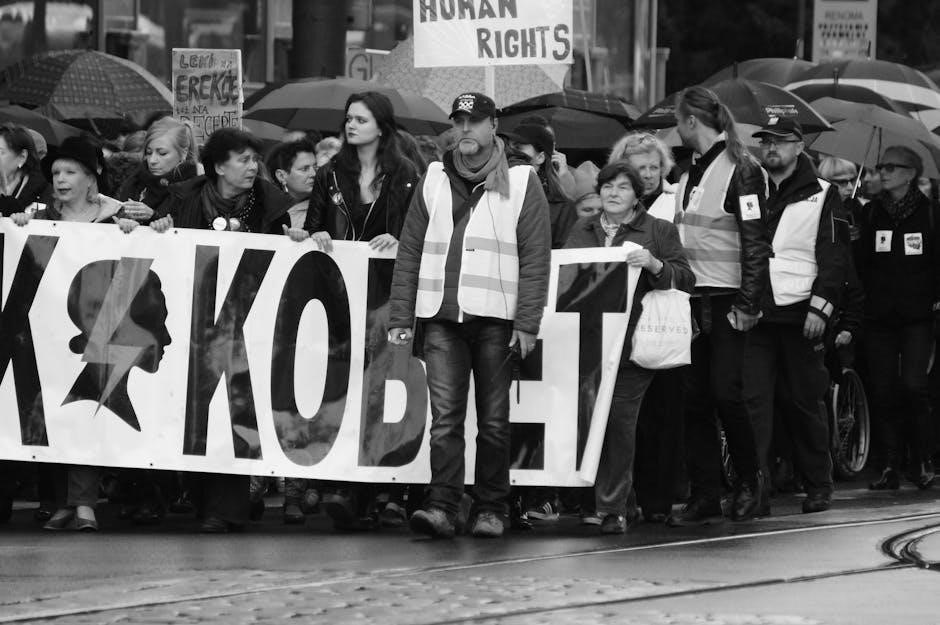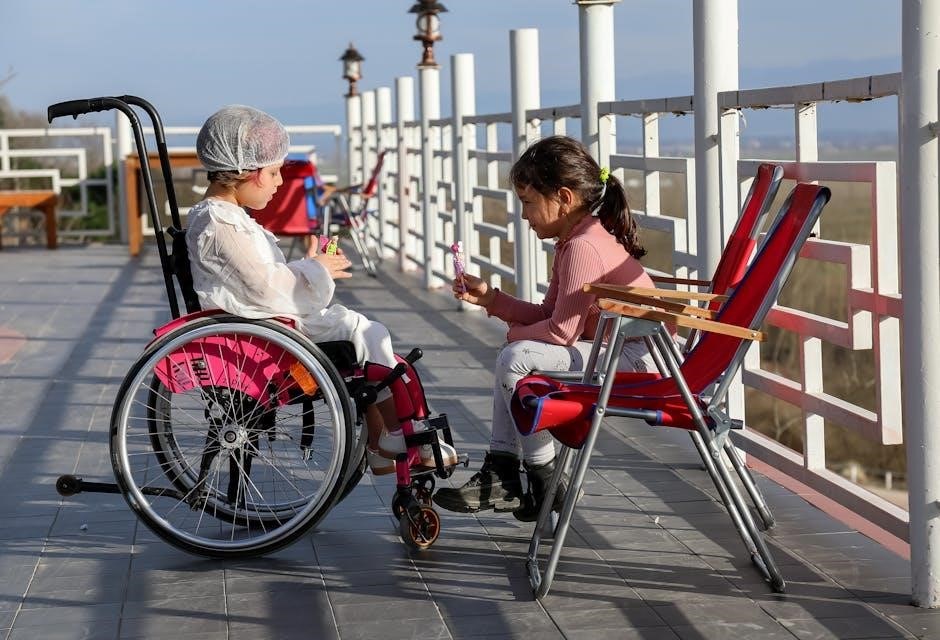Situational awareness is the ability to accurately understand one’s surroundings, events, and actions. It’s crucial for workplace safety, helping prevent incidents through perception, comprehension, and anticipation.
1.1 Definition and Importance
Situational awareness is the ability to accurately understand and interpret one’s surroundings, events, and actions. It is vital for workplace safety, enabling individuals to perceive hazards, comprehend risks, and anticipate potential dangers. By maintaining situational awareness, employees can make informed decisions, reduce incidents, and enhance overall safety protocols, ensuring a proactive approach to hazard prevention and management.
1.2 Role in Workplace Safety
Situational awareness plays a pivotal role in workplace safety by enabling employees to identify and respond to potential hazards. It fosters a proactive approach to risk management, allowing individuals to anticipate dangers, communicate effectively, and implement safety protocols. By staying alert to their environment, workers can prevent incidents, reduce injuries, and maintain a safer, more efficient work environment.
The Role of Toolbox Talks in Promoting Situational Awareness
Toolbox talks are essential for fostering situational awareness by discussing practical safety tips and strategies to enhance workplace safety and awareness among team members.
2.1 What Are Toolbox Talks?
Toolbox talks are brief, informal discussions held before tasks to review safety practices, discuss potential hazards, and reinforce situational awareness. They are essential for ensuring workers understand risks and safety protocols, fostering a culture of awareness and collaboration to prevent incidents on the job site.
2.2 How Toolbox Talks Enhance Safety Awareness
Toolbox talks enhance safety awareness by fostering open discussions on potential hazards, promoting situational awareness, and reinforcing safe practices. They ensure workers are informed, vigilant, and proactive in identifying risks, creating a safer work environment through shared knowledge and collective responsibility.
Key Components of Situational Awareness
Situational awareness involves perception, comprehension, and anticipation of surroundings; It enables individuals to identify hazards, understand their implications, and predict potential risks, ensuring proactive safety measures.
3.1 Perception of Surroundings
Perception of surroundings is the foundation of situational awareness, involving the accurate detection and interpretation of environmental factors, such as people, equipment, and hazards. It requires constant vigilance and attention to detail to identify potential risks and ensure safety in the workplace. This awareness helps individuals stay alert and proactive in preventing incidents.
3.2 Comprehension of Hazards
Comprehension of hazards involves understanding the significance and potential risks of perceived surroundings. It requires analyzing the severity and likelihood of hazards, enabling workers to prioritize and address threats effectively. This step is critical for decision-making and taking proactive measures to mitigate risks, ensuring a safer and more efficient workplace environment through improved situational awareness.
3.3 Anticipation of Potential Risks
Anticipation of potential risks involves predicting possible hazards based on surroundings and circumstances. It builds on perception and comprehension, enabling proactive measures to prevent incidents. Regular safety scans, like the 10-Second Safety Scan, foster this skill, helping workers foresee dangers and take preventive actions to ensure a safer work environment through heightened situational awareness.
Practical Examples of Situational Awareness in the Workplace
- Identifying safety zones to avoid accidents and stay out of harm’s way.
- Recognizing equipment hazards through regular inspections and environmental scans.
- Utilizing the 10-Second Safety Scan to quickly assess risks and prevent incidents.
4.1 Staying Out of the Line of Fire
Situational awareness helps employees avoid being in the path of moving objects or forces. A line of fire is present when a person’s body intersects with a hazard’s trajectory. Workers with strong situational awareness position themselves safely, minimizing risks and preventing accidents. This proactive approach ensures a safer workplace by anticipating potential dangers.
4.2 Recognizing Equipment and Environmental Hazards
Situational awareness helps workers identify equipment and environmental hazards by staying alert to machine operations and changing conditions. The 10-Second Safety Scan is a valuable tool for this purpose, ensuring a proactive approach to minimizing risks and preventing incidents in the workplace. Recognition of these hazards is key to maintaining a safe environment.
4.3 Utilizing the 10-Second Safety Scan
The 10-Second Safety Scan is a quick yet effective method to enhance situational awareness. It involves pausing to visually assess surroundings, identify potential risks, and ensure a safe working environment. This practice promotes proactive hazard identification, improving response times and reducing incident likelihood. Regular use of this scan fosters a culture of safety and vigilance in the workplace.

The 10-Second Safety Scan
The 10-Second Safety Scan is a quick, effective method to heighten situational awareness. It involves pausing to assess surroundings, identify risks, and ensure a safe environment, fostering proactive safety and preventing incidents.
5.1 How to Conduct the Scan
To conduct the 10-Second Safety Scan, pause, observe your surroundings, and identify potential hazards. Scan horizontally, check for moving objects, and assess environmental risks. This proactive approach helps reduce risks and prevents incidents by fostering a habit of constant situational awareness in the workplace.
5.2 Benefits of Regular Scanning

Regular scanning enhances safety by identifying potential hazards early, reducing risks, and fostering a proactive approach to workplace safety. It helps maintain situational awareness, prevents incidents, and creates a safer environment for everyone. Consistent scanning ensures continuous focus and awareness, which are critical for protecting oneself and others in dynamic work settings.

Decision-Making in High-Stress Situations
Decision-making in high-stress situations requires clear thinking and quick action. Situational awareness helps reduce panic, enabling effective decisions to prevent incidents and ensure safety.
6.1 The STOP Methodology
The STOP methodology is a structured approach to decision-making in high-stress situations. It involves stopping to assess risks, thinking clearly about potential hazards, observing the environment, and proceeding safely. This method enhances situational awareness, ensuring workers make informed decisions to maintain safety and prevent incidents effectively in the workplace.
6.2 Assessing Hazards and Taking Action
Assessing hazards involves identifying potential risks and evaluating their severity. Workers should take immediate action to mitigate dangers, such as removing hazards or reporting them. Effective communication with the team ensures collective awareness and prompt resolution. This proactive approach, supported by tools like safety checklists, enhances workplace safety and prevents incidents. Timely action is crucial.

Common Hazards Identified Through Situational Awareness
Common hazards include human errors, equipment malfunctions, and environmental risks. Situational awareness helps identify these threats, enabling timely interventions to ensure workplace safety and prevent incidents effectively.
7.1 Human Factors
Human factors, such as fatigue, stress, and distractions, significantly impact situational awareness. These elements can impair judgment and reaction times, increasing the likelihood of workplace incidents. Addressing these factors through training and awareness is essential to maintaining a safe environment and ensuring employees remain vigilant and proactive in identifying potential risks. Regular breaks and stress management techniques can mitigate these challenges effectively.
7.2 Equipment-Related Risks
Equipment-related risks, such as malfunctions or improper usage, pose significant threats in the workplace. Conducting regular inspections and providing proper training ensures equipment operates safely. Situational awareness helps workers identify potential equipment hazards promptly, enabling preventive actions and minimizing risks to personnel and operations. Maintenance schedules and safety protocols are critical in mitigating these risks effectively.
7.3 Environmental and Weather Conditions
Environmental and weather conditions, such as rain, snow, or extreme heat, can significantly impact workplace safety. Situational awareness helps workers identify and adapt to these hazards, ensuring tasks are performed safely. Monitoring weather forecasts and adjusting work plans accordingly minimizes risks posed by environmental factors, protecting both personnel and equipment from potential harm. Stay vigilant to changing conditions.

Best Practices for Maintaining Situational Awareness
Stay alert, communicate proactively, and conduct regular safety checks. Use tools like the 10-Second Safety Scan to stay vigilant and adapt to changing conditions effectively.
8.1 Staying Focused on the Task
Maintaining focus on the task at hand is essential for situational awareness. Minimize distractions, prioritize tasks, and avoid multitasking to ensure full attention on potential hazards and risks, enhancing workplace safety and efficiency.
8.2 Communicating with Team Members
Effective communication with team members is vital for situational awareness. Share observations, discuss potential hazards, and coordinate actions to ensure everyone is informed and aligned. Regular updates and open dialogue foster a collaborative environment, reducing risks and enhancing overall safety on the jobsite.
8.3 Regular Safety Briefings
Regular safety briefings are essential for reinforcing situational awareness. These sessions provide a platform to discuss potential hazards, review safety protocols, and share experiences. By conducting them consistently, teams stay vigilant, adapt to new risks, and foster a proactive safety culture, ultimately preventing incidents and ensuring a secure working environment.
Conducting Effective Toolbox Talks on Situational Awareness
Effective toolbox talks on situational awareness involve clear preparation, engaging discussions, and practical examples. They ensure teams understand risks, fostering proactive safety behaviors and incident prevention through shared knowledge.
9.1 Preparing for the Talk
Preparing for a situational awareness toolbox talk involves identifying the audience, outlining key points, and gathering visual aids like diagrams or PDF resources. Tailor content to workplace specifics, ensuring relevance and engagement. Use real-life examples to illustrate concepts, fostering understanding and participation. Emphasize practical tips to enhance awareness and encourage proactive safety behaviors.
9.2 Engaging the Audience
Engage participants by encouraging open discussions and asking reflective questions about their experiences. Use visual aids and real-life scenarios to illustrate key points. Foster interaction by incorporating group activities or safety-related challenges, ensuring everyone feels involved and invested in enhancing situational awareness. This approach promotes active learning and reinforces safety culture.
9.3 Follow-Up Actions
After the toolbox talk, review key points and assign related tasks to reinforce learning. Encourage participants to share observations and feedback. Provide additional resources, like the situational awareness toolbox talk PDF, for further reference. Follow up with team members to ensure continuous improvement and accountability, fostering a culture of ongoing safety awareness and adaptation.

Case Studies: Incidents Prevented by Situational Awareness
Real-life examples highlight how situational awareness prevented incidents by identifying potential hazards early, enabling timely interventions and ensuring safer outcomes in high-risk environments.
10.1 Real-Life Examples
Situational awareness prevented incidents in various industries. For instance, a construction worker spotted an unstable structure, halting work until it was secured. Similarly, an employee noticed a chemical leak, enabling timely containment. These examples demonstrate how heightened awareness averted potential disasters, underscoring its critical role in workplace safety and incident prevention strategies.
10.2 Lessons Learned
Lessons learned from real-life examples highlight the importance of maintaining situational awareness to prevent incidents. Continuous training, open communication, and proactive hazard identification are key. Encouraging a culture of awareness ensures safer workplaces and fosters a mindset of vigilance among employees, ultimately reducing risks and enhancing overall safety standards.
Tools and Resources for Enhancing Situational Awareness
Enhance situational awareness with the Situational Awareness Toolbox Talk PDF, safety checklists, and visual aids for a safer workplace environment.
11.1 Situational Awareness Toolbox Talk PDF
The Situational Awareness Toolbox Talk PDF is a free resource packed with practical tips and engaging visuals to enhance workplace safety. It provides real-life examples, strategies, and exercises to boost situational awareness. This tool is ideal for training sessions, helping teams stay alert and proactive in identifying hazards. Download it now to foster a safer work environment.
11.2 Safety Checklists and Visual Aids

Safety checklists and visual aids are essential tools for enhancing situational awareness. They provide step-by-step guides to identify hazards and ensure compliance with safety protocols. Infographics, posters, and signs act as reminders, helping workers stay vigilant. These resources complement toolbox talks and are critical for maintaining a proactive approach to workplace safety and risk reduction.
Situational awareness is a critical factor in workplace safety, enabling employees to prevent incidents and respond effectively. Regular practices like the 10-Second Safety Scan and toolbox talks foster a culture of vigilance and proactive safety measures, ensuring a safer work environment for all.
12.1 Recap of Key Points

Situational awareness is a critical factor in workplace safety, involving perception, comprehension, and anticipation of risks. Toolbox talks and practices like the 10-Second Safety Scan enhance this skill, fostering a culture of awareness and proactive safety measures to prevent incidents and protect employees.
12.2 Encouraging a Culture of Awareness
Situational awareness fosters a proactive approach to workplace safety. Regular toolbox talks and discussions encourage employees to stay vigilant. Promoting collaboration and accountability among team members enhances overall safety. By sharing experiences and insights, a culture of awareness is cultivated, ensuring a safer environment for everyone;



